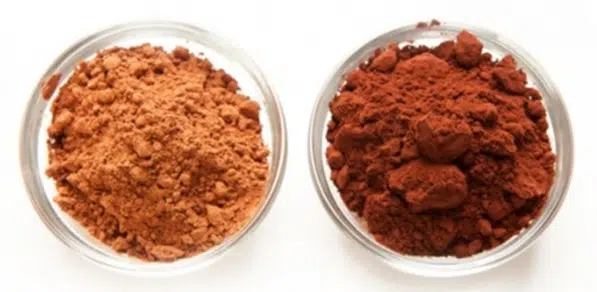Best Cocoa Powder for Baking and Drinking: Guide to Choose
The History of Cocoa Powder
To explore the secret of cocoa podwer for baking and drinking, first, let’s take a look at the history of cocoa powder.
The word cocoa first appeared in about 1500-400 BC (3000 years ago), when the Mayans and Aztecs realized that cocoa fruit was edible and began to grow cocoa trees in equatorial South America, saying it is cacau.
They dried and crushed cocoa beans, mixed with water, added spices, chili and vanilla to make a bitter drink called Chocolati (meaning “hot drink”, which is also the source of the word cocoa) special tribute to the noble royal family for drinking.
Cocoa beans were also used as a trading currency, unit of measurement, and post-war rewards. For example, 4 cocoa beans could buy a rabbit, 100 cocoa beans could buy a slave, showing its influence.
In the 16th century, the Spaniards discovered the plant and drink. They realized its amazing potential value. Adjusted the taste and added cane sugar, vanilla, cinnamon and pepper to reduce bitterness.
Chocolate spread quickly to other parts of Western Europe. In the 17th and 19th centuries, the industrial revolution accelerated the production of cocoa powder and the price began to drop.
The innovation and consumption of chocolate continued to expand. Solid chocolate, chocolate bars, and chocolate candies with fillings were launched one after another.
Cocoa industry and by-products began developing all over the world.
Today, the world consumes more than 4.5 million tons of cocoa beans each year. Cocoa is still one of the most popular drinks in the world. The ancient Central Americans who pioneered this crop should not be able to imagine that cocoa would be so affirmed one day.
The Source of Best Cocoa Powder
Cocoa beans are the most important raw material for making cocoa powder. It comes from the cocoa fruit produced by the cacao tree. About 20-40 cocoa beans can be obtained from each fruit. The cocoa tree is a tropical plant that is most suitable for growing in a hot and rainy environment.
The main production areas are located in the 20 degrees north and south latitudes of the equator in Central and South America, West Africa and Southeast Asia. In recent years, farmers in Nantou and other places in Taiwan have also actively invested in cocoa planting.
Cocoa beans are mainly divided into the following 3 varieties, with slightly different flavors.
1. Criollo
Production: A natural variety. It accounts for about 3% of the world’s total cocoa bean production. Due to the fact that Criollo is very afraid of pests, it is not easy to plant. Thus, stands out as the top cocoa bean variety.
Distribution: Mainly Distributed in Venezuela, Mexico, Guatemala, Nicaragua, Colombia and other places in South America.
Appearance & Flavor: The color of the pods is green with yellow, or green with red, and cocoa beans are gray, which is easy to distinguish. With a unique and delicate aroma, the flavor will not be too sour and bitter.
2. Forastero
Production: A natural variety. It accounts for more than 80% of the total production of cocoa beans in the world. It is easy to cultivate, resistant to diseases and insect pests, and has strong fecundity. It is the most common and most produced cocoa variety on the market.
Distribution: Mainly distributed in Brazil, West Africa, and Southeast Asia.
Appearance & Flavor: The pods are light green, yellow, and light purple, etc., and cocoa beans are dark purple. Chocolate has a lighter scent, with strong astringency, bitterness and sourness, and is often used in cheap chocolate.
3. Trinitario
Production: It is a mixed species formed by the mating of Criollo and Forastero, so it has the characteristics of these two species at the same time and is easier to cultivate. It accounts for about 20% of the world’s total cocoa production.
Distribution: The place of origin is Trinidad Islands in the Caribbean Sea.
Appearance & Flavor: It has the characteristics of Criollo and Forastero. The taste is relatively strong and thick with a little fruity fragrance.
Types of Cocoa Powder
In general, pure cocoa powder can be divided into two types according to the manufacturing process. One is Natural Cacao Powder and the other is Alkalized Cacao Powder.
However, being “natural” is not completely better than the others. How to choose the best cocoa powder for baking and mixing, are introduced as follows:
1. Natural Cocoa Powder
Each cocoa bean contains about 50-60% of cocoa butter and cocoa solids. After the cocoa beans are harvested, the cocoa paste can be extracted through fermentation, sun-drying, baking, crushing, shelling, and grinding.
Then the cocoa butter in the cocoa paste is squeezed and separated, and the remaining part is dried and ground into powder. This is what everyone often calls natural pure cocoa powder.
Natural cocoa powder is light brown color, because it retains the most original cocoa flavor in the process. It is more acidic, bitter, and has a complex taste. It also has less oil and is not easily dissolved in water, so it is more often used than blended drinking.
Used to make solid products, such as baking biscuits or cakes. The sourness of natural cocoa powder can react with the added baking soda when making cakes or desserts to release titanium dioxide. This increases the degree of fermentation, which improves baked cakes’ aroma and texture.
2. Alkalized Cocoa Powder
Invented by Van Houten, a Dutch chemist. It is also called Dutch Cacao Powder. It refers to adding an alkalization step during the process of cocoa beans to adjust the pH value of cocoa powder and reduce bitter taste.
Compared with natural cocoa powder, alkaline cocoa powder is darker in color with a brownish-red or even black. It has a stronger aroma and a smoother taste. It is also easier to dissolve in water, so it has a wide range of uses.
In addition to baking, it is also very suitable to prepare cocoa drinks. A proper amount of alkalization can increase the stability of the cocoa powder and a good flavor, but excessive alkalization will still cause the cocoa to taste weaker and have a strong alkali taste.

*(Picture Above) The picture on the left is natural cocoa powder with a lighter color, and the picture on the right is alkalized cocoa powder with a darker color. A suitable cocoa powder can be chosen according to different applications.
Content of cocoa butter
Cocoa powders can be divided into three types according to the content of cocoa butter. High-fat cocoa powder, medium-fat cocoa powder, and low-fat cocoa powder.
- High fat cocoa powder: 20-24%
- Medium fat cocoa powder: 10-12%
- Low fat cocoa powder: 8%
Among three kinds of the cocoa powder, low fat cocoa powder has the worst quality, because cocoa butter is a healthy medium chain acid. Cocoa butter is rich in cocoa’s special aroma and nutrients. Therefore, less cocoa butter relates to less nutrition value of cocoa powder.
Common Use for Cocoa Powder
Cocoa powder has a strong cocoa aroma and can be used in chocolate, ice cream, candies, pastries and other cocoa related foods.
Cocoa powder for baking, beverages and solid processing have an important position.
The Nutrition Value of Cocoa Powder
Cocoa powder is a powder extracted and refined from cocoa beans.
It contains protein, a variety of minerals, vitamins and theobromine with biologically active functions, including calcium, copper, magnesium, phosphorus, potassium, sodium, zinc, and vitamins A, D, E, B1, B2, B6.
The content of these minerals in cocoa powder is higher than cocoa butter and chocolate mass. Each 100 grams of cocoa powder contains about 230 mg of caffeine and 2.057 grams of theobromine, but most other products of cocoa beans do not contain these ingredients.
Cocoa powder is rich in flavonoids, which is natural antioxidants. For example, red wine and black tea also has the ingredients that is beneficial to the body.
However, the retaining content depends on the processing and manufacturing process of cocoa powder. During the alkalization process, it is easy to reduce the content of flavonoids.
How to Choose Best Cocoa Powder for Baking
Note 1: Choose cocoa powder with the right color
The color of natural cocoa powder should be light brown. If natural cocoa powder is brown or even dark brown, food coloring may be added; the color of alkalized cocoa powder should be brown-red, if it is dark brown or brown-black, it should be too alkalized that caused by excessive ash content.
Note 2: Choose non burnt smell cocoa powder
Natural cocoa powder should have a light fragrance of natural cocoa. If it smells strong or burnt, it is because of poor quality. Alkalized cocoa powder has a stronger cocoa aroma than natural cocoa powder, and should not have a burnt smell as well.
Note 3: Choose finer cocoa powder
The fineness of cocoa powder is very important for the production of chocolate. The chocolate produced by cocoa powder with substandard fineness has a poor taste and a rough feeling. A small amount of cocoa powder can be placed on white paper, gently folded and wiped by hand. The powder with a fineness of 99 or more will be distributed on the paper evenly, and the powder with a fineness of less than 99 would have a bad feeling and uneven distribution.
Note 4: Choose medium fat cocoa powder with 10-12% cocoa butter content
Although cocoa powder with high cocoa butter content has a strong aroma, if it is used to make cakes, it will easily affect the foaming of the protein.
Moreover, the quality of cocoa powder with low cocoa butter content is not good, including its flavor and nutrients. Therefore, it is recommended to use medium fat cocoa powder for baking.
High Tea Cocoa Powders’ Introduction & Advantages
High Tea has selected three high quality alkalized cocoa powders for you, very suitable for baking and blending with beverages.
1. High Fat Cocoa Powder
Origin: Netherlands
Cocoa Butter content: 22-24%
pH value: 6.8-7.2
Introduction: The taste is smooth and the solubility is high. Strong and wide applicability, the rich cocoa butter leaves you with an endless aftertaste.
Color: Full reddish brown
Application: Surface powder, flavor drinks, and ice cream
2. Medium Fat Cocoa Powder
Origin: Netherlands
Cocoa Butter content: 10-12%
pH value: 7.2-7.6
Introduction: Continuing the century-old Dutch production process, cocoa powder has a rich, slight bitter and sweet aroma.
Color: Deep reddish brown
Application: Flavor drinks, 3 in 1 drinks, baking, ice cream
3. Medium Fat Cocoa Powder II
Origin: Indonesia
Cocoa Butter content: 10-12%
pH value: 7.0-7.4
Introduction: The taste is closest to the taste of Ovaltine, and is the most familiar taste for adults and children.
Color: Reddish brown (light alkali)
Application: Flavor drinks and baking
Related Article
If you want to know more about cocoa powder products from High Tea, please feel free to contact us. We will reply as soon as possible and provide you with considerate service.
Email: [email protected]
Address: No.26, Wuquan 6th Rd., Wugu Dist., New Taipei City 24889, Taiwan




